November 18 - 24, 2012: Issue 85
HEAVENLY SONGS IN SOIBADA
By Steve Meacham
Travel writer Steve Meacham witnessed the 2012 pilgrimage to the hilltop Catholic shrine of Our Lady of Aitara in a beautiful and remote part of Timor Leste. He came away with great respect for the Timorese people - and, though an atheist, an understanding of what the pilgrimage means to their national psyche.
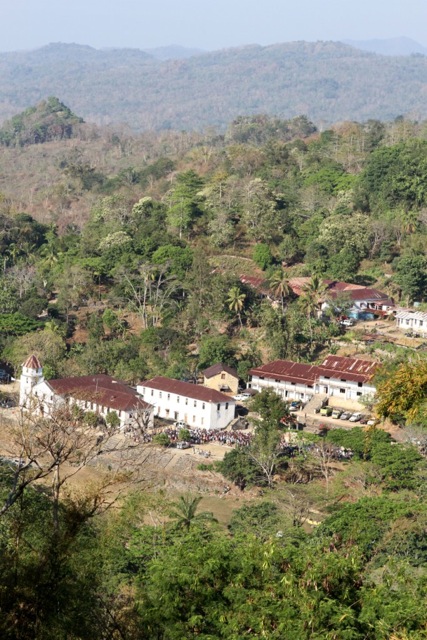 We’ve been in Soibada in the mountain heart of Timor Leste for a week, and so have become accustomed to the unexpected. But this is truly shocking. I’m one of four middle aged men sharing a dormitory room in the presbytery that adjoins the parish church, Sacred Heart. And when the cast iron bell in the church tower begins to ring as usual at 5.30am, we feel we have plenty of time - possibly hours - to get to morning mass.
We’ve been in Soibada in the mountain heart of Timor Leste for a week, and so have become accustomed to the unexpected. But this is truly shocking. I’m one of four middle aged men sharing a dormitory room in the presbytery that adjoins the parish church, Sacred Heart. And when the cast iron bell in the church tower begins to ring as usual at 5.30am, we feel we have plenty of time - possibly hours - to get to morning mass.
By now we are used to “Tetum time”, meaning events take place in no direct relationship to the official schedule.
But minutes later we hear beautiful male voices in the church below.
It’s just before dawn on Saturday, and the annual weekend pilgrimage through the dusty roads of Soibada - commemorating a mysterious visitation many years ago and culminating in a mass in a beautiful hilltop chapel - has begun. Now that Australia’s own saint, Mary MacKillop, has been officially recognised by the Vatican, we will soon no doubt have our own home-grown religious trail.
But until then, the annual pilgrimage on the eastern half of Timor, just 700 kms or one hour’s flight away from Darwin, remains one of our closest sacred travel experiences. And yet very few people in Australia - even devout Catholics - know anything about it.
Our group consists of members or affiliates of Pittwater Friends of Soibada, an ecumenical charity on Sydney’s Northern Beaches seeking to improve the lives of children in this poverty-stricken region of Timor Leste. We’re told we are the first Australian visitors to witness the pilgrimage.
The festivities had begun on Friday afternoon, when truckloads of pilgrims from all over Timor Leste had started to arrive at the presbytery. Men, women and children tumble out of the open-top lorries, still smiling after uncomfortable journeys of up to ten hours along dusty, rough-hewn tracks. More pilgrims will come today: whole villages, entire congregations.
Each new lorryload sets up its tents in pre-ordained patches of grass, or assumes temporary occupancy of one or other of the once-beautiful Portuguese colonial era buildings in the village centre which now need huge bucks spent on them to make them fit for human habitation.
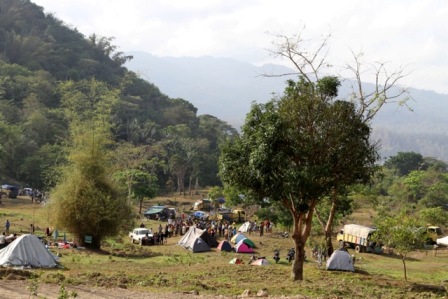 By Sunday morning when the three-day celebration reaches its climax, the number has swelled to around 3000, but that is still in the future.
By Sunday morning when the three-day celebration reaches its climax, the number has swelled to around 3000, but that is still in the future.
Our party of nine had arrived several days ago from Dili, the country’s capital. The five women in our group have joined the Benedictine nuns under the tiny but formidable figure of Sister Rosario in the historic convent which now houses one of Timor Leste’s best-known orphanages.
We four men in the presbytery are the guests of Father Abel Guterres, Soibada’s parish priest. Since at least 95 per cent of the people within the Soibada’s boundaries are Catholic, the battered presbytery is the pilgrimage headquarters for the duration.
Both Soibada’s convent and presbytery would be considered sites of national heritage significance in Australia. But here in Timor, both are falling down for lack of funds. Their iron rooves are twisted and rusted beyond repair, termites riddle the rafters, the floorboards of the two storey presbytery are so rotten visitors risk plummeting to the ground floor.
In Sydney, both buildings would be cordoned off immediately for fear of injury or litigation. In Soibada, decay is just a fact of life to be worked around. There are simply too many more urgent priorities in Timor Leste - one of the world’s most poorest countries - to worry about.
We’d been warned in advance about the privations we might experience. But in reality, there’s nothing you wouldn’t expect in any third world country - with the wonderful bonus that everything in Soibada seems to come with a smile.
Obviously, there’s a communication problem. Timor Leste’s official language is Portuguese (a controversial choice when independence was won), but most people here speak Tetum - and no English.
Yet there is so much goodwill among the locals and the pilgrims, our group is welcomed each time we utter a simple Bondia (Good morning) or Bonoite (Good evening).
Obviously we’ve come in October to experience the pilgrimage, but it is also the tail end of the country’s dry season when the roads to Soibada are more accessible. In previous visits, Pittwater Friends of Soibada representatives have endured excruciatingly long, arduous and even dangerous journeys over the mountain ranges from Dili.
In 2011, the wet season came early and pilgrim numbers were understandably down. But this October, we are experiencing more typical tropical weather for Soibada for this time of year. Hot during the day, but not as humid as nearby Dili or Darwin. Cooler at night, but not so chilly as to deter mosquitos.
So what exactly happened - and when - to cause all these pilgrims to be here? That‘s open to question. What is indisputable is that, on a hill high above Sacred Heart is a picturesque chapel, the National Shrine of Our Lady of Aitara.
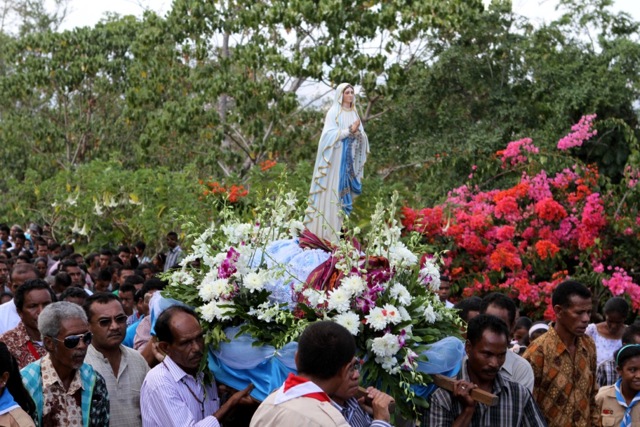 Legend says the Virgin Mary appeared to several local women who were gathered under a massive Banyan tree at the top of Aitara, a hill already considered sacred to the Timorese before the Portuguese brought Christianity to the eastern half of Timor in the 16th Century.
Legend says the Virgin Mary appeared to several local women who were gathered under a massive Banyan tree at the top of Aitara, a hill already considered sacred to the Timorese before the Portuguese brought Christianity to the eastern half of Timor in the 16th Century.
What day, which month, what year this miraculous event apparently occurred isn’t known. But the visitation is now celebrated annually on the weekend closest to Oct 16 - and has been for the past hundred years.
The apparition is the reason the Portuguese colonial authorities built a shrine, a church, a convent, a college and a town in Soibada. For many decades - particularly during the brutal years of the Indonesian occupation from 1975-1999 - the annual trek to Soibada became a touchstone of Timorese solidarity and national identity.
As Jose Ramos-Horta - the Nobel Peace Prize-winning resistance leader turned international statesman - has admitted, Timor Leste might never have gained independence from Indonesia but for the Christian bonds of its people. Certainly, many Catholic priests took enormous personal risks to keep Timorese spirit alive during the two and a half decades of brutal rule from Jakarta.
And while the Catholic Church has never officially endorsed the Marian vision at Aitara, Pope John Paul II - who came to Timor Leste during the Indonesian occupation - referred to Our Lady of Airara in his message in May 2002 celebrating the country’s independence.
A decade later, the number of pilgrims is even greater. Dr Ramos-Horta (who, like many leaders of Timor Leste went to school in Soibada) took part in the pilgrimage when he was president of the republic. And this weekend, the man who recently beat him in the 2012 presidential election, Taur Matan Ruak, is guest of honour.
At the presbytery, there’s even talk that Timor Leste’s most famous politician - Xanana Gusmao (former guerilla leader, the country’s first democratically-elected president and now Timor Leste’s prime minister) - will also arrive on Saturday and camp overnight.
In fact, the appearance at the 2012 pilgrimage has been delegated to Jose Luis Guterres, the vice prime minister for social affairs, who pitches tent with his bodyguards down by Mota Sahen, the river which for several weeks of the year separates Soibada from the rest of Timor Leste.
Even so, the presence of the national president, the deputy prime minister, and two of the country’s three bishops (the missing one is visiting the Vatican, we’re told) confirms the importance of the yearly pilgrimage to the shrine of Our Lady of Aitara to Timor Leste’s psyche and national identity.
Our party is fairly evenly divided between devout Catholics, lapsed Christians and outright atheists (myself included). But we are all here in Soibada to witness a celebration of faith and the human spirit. For some of us, this pilgrimage is no different - and just as illuminating - as watching the Islamic Haj to Mecca, a Hindu burial service on the river Ganges or a Buddhist ceremony in Nepal. The fact it is happening in our next door neighbour’s back yard makes it all the more exotic and intriguing.
The tension had started several days beforehand. Usually Soibada only has electricity for around six hours after dark. But during the three days of the pilgrimage, it is needed round the clock, so a high-powered team from Dili is sent in to make sure resources are borrowed from elsewhere for the duration.
The same is true of the water supply. Usually the villagers of Soibada collect their water each day from communal taps. But during the Our Lady of Aitara festival, the demand is much greater. Unscrupulous (or ingenious?) pilgrims aren’t adverse to diverting the water pipes from one outlet to their own.
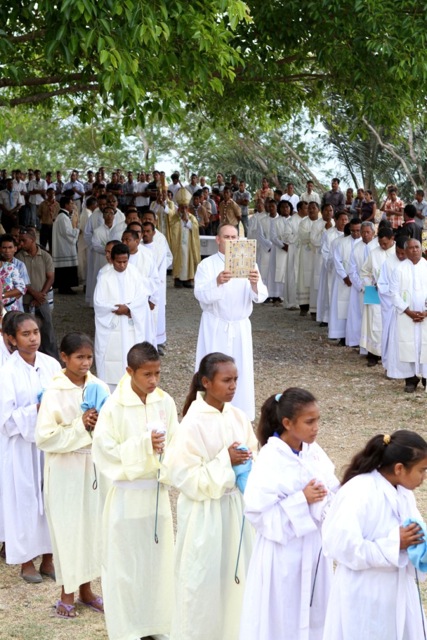 During Friday night, our dormitory quartet has been woken several times by mobile phones ringing - and loud conversations in reply from the Timorese officials charged with solving problems.
During Friday night, our dormitory quartet has been woken several times by mobile phones ringing - and loud conversations in reply from the Timorese officials charged with solving problems.
Yet the previous evening had seemed so seamlessly enjoyable. As soon as the pilgrims had pitched their camps, they’d immediately begun setting up food stalls to cater for their flock and raise money for the pilgrimage.
At 6pm, an outdoor mass had started, presided over by the Bishop of Dili . His homily (in Tetum) had provoked waves of genuine laughter from the pilgrims (waking up some of the gently-sleeping priests on the impressive podium from their well-deserved slumber).
After the outdoor service, our group had walked round the makeshift nightlife, tasting various delicacies from the food stalls. Some had musical accompaniments as different congregations rehearsed their choral performances the following day.
On Saturday morning, the pilgrimage revolves around a multitude of masses. Each encampment celebrates its own service during the morning, resulting a mountainside of melody.
In the late afternoon, a candlelit procession begins from the church after a packed Anointing of the Sick mass in which physically impaired pilgrims had been blessed.
The column of bishops, priests, nuns and fellow worshippers makes its slow way round the village on a pre-ordained route marked by bamboo decorations, lovingly made by villagers over the past couple of days. The pilgrims march behind a tiny priest carrying the golden Monstrance, containing the Blessed Sacrament.
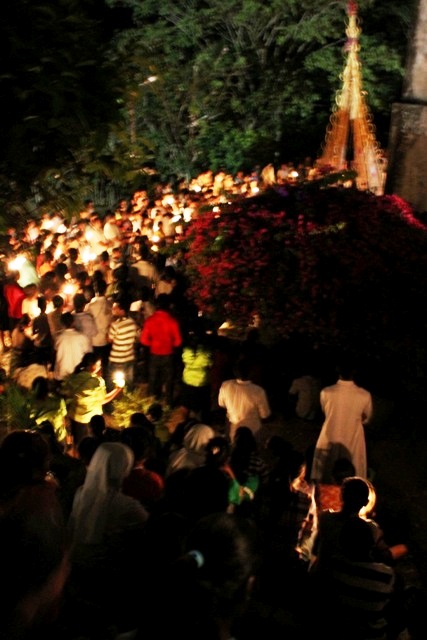 As the night becomes darker, the procession looks like a gigantic, illuminated snake winding through the village. Then, when the worshippers have returned to the church and the WWW has been put back in place, the crowd disperses once again among the food stalls. This is a time for old friends to catch up, and new friendships be forged. Outside the presbytery, a throng of teenagers gathers on the stairs - continuing their good natured banter well into the early hours.
As the night becomes darker, the procession looks like a gigantic, illuminated snake winding through the village. Then, when the worshippers have returned to the church and the WWW has been put back in place, the crowd disperses once again among the food stalls. This is a time for old friends to catch up, and new friendships be forged. Outside the presbytery, a throng of teenagers gathers on the stairs - continuing their good natured banter well into the early hours.
Sunday begins urgently around 5am in the presbytery. Apart from the four of us, the building is playing host to around 30 other guests - some of whom have key roles in the pilgrimage. They’re clearly focused: the whole atmosphere of Soibada seems to have changed. This is what everyone has travelled such distances for.
The march to the chapel is due to start at 8am, following a Rosary and a communal breakfast for all the clergy.
But being dispensable, one of my colleagues, Avalon hairdresser Ian Laidlaw, and I volunteer to go down to the river because the orphans at the covent have run out of water again. It takes us an hour to drive down the mountain, fill up a dozen large plastic water carriers from the fast-moving rivulets, and deliver them to the orphanage kitchen. By that time, it’s nearly 9am, and most of the clergy and pilgrims have already made their way to the summit of Aitara. Ian and I hastily join the stragglers making up the tail end of the procession walking the gentle slope to the hilltop chapel.
Around 3000 smartly-dressed people are gathered for the mass, conducted from a specially-erected stage. A separate podium houses the visiting politicians and dignitaries.
The mass, conducted in Tetum, takes around a hour. Even this early, the sun is hot and several onlookers nod off. Locals - and visitors who have attended the pilgrimage before - have grabbed the available shade, including under the spreading limbs of the banyan tree where the Virgin is said to have appeared all those years ago.
Once the religious duties are complete, the politicians get their chance to address the captive audience. Judging by the laughter as we make our way down the hill, they know levity and brevity are the orders of the day. After all, both VIPs and other villagers have long journeys to make this afternoon.
By 1pm, most of the tents have been packed away, the food stalls demolished and the trucks either on their way or about to set off.
By mid afternoon, Soibada has returned to its usual slumberous state. A sense of tranquility has descended again. Only the piles of rubbish - left, ignorantly, to be washed away in the next rain - betrays the pilgrims were ever here.
But for our party, the pilgrimage will remain long in our memories. Whatever our individual religious beliefs, this weekend in Soibada has demonstrated the power and importance of ceremony and shared experience in Timor Leste’s culture.
TRAVEL DETAILS:
The pilgrimage in Soibada takes place each October, on the weekend closest to Oct 16. Air North operates daily flights between Darwin and Dili. Car and driver can be hired in Dili.
Copyright Steve Meacham, 2012. Photos by Peta Wise, 2012. All Rights Reserved.